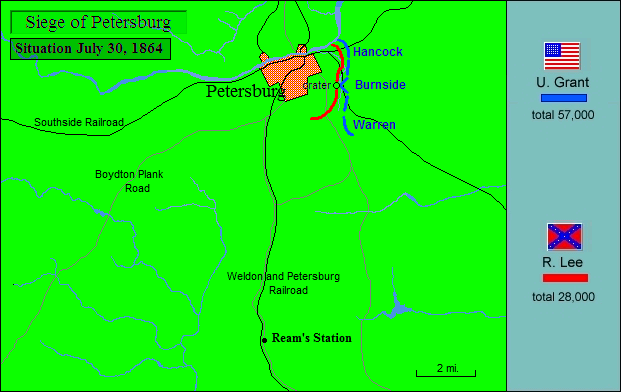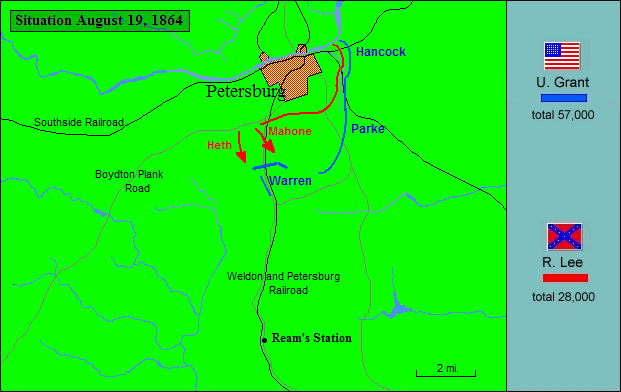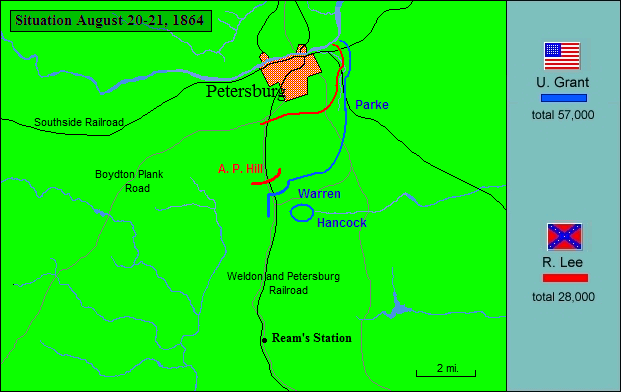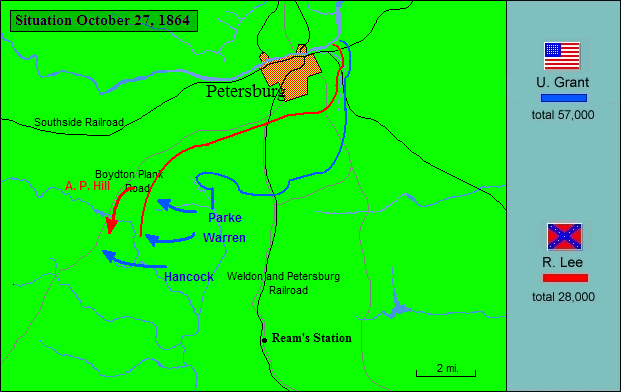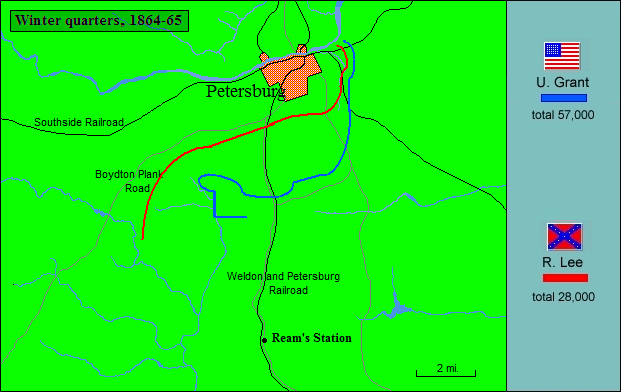Then the king of the north shall come and throw up siegeworks, and take a well-fortified city. And the forces of the south shall not stand, or even his picked troops, for there shall be no strength to stand.
–The Book of Daniel
By the summer of 1864 the North had thrown up siegeworks against at least two well-fortified Southern cities: Atlanta and Petersburg. It seemed to many–to no one more than Abraham Lincoln himself–that the fate of those cities would decide the fall elections in the North, and hence the question of the Union’s will to wage war. Standing fast, the strongholds would perhaps demonstrate to a majority that the Chicago platform was right, the war was a failure. Before those elections, however, William Tecumseh Sherman intended to wreck his way into Atlanta in the West while Ulysses S. Grant battered his way into Petersburg in the East. Grant’s job would be immensely difficult. Back in the middle of June, Baldy Smith might have stormed Beauregard’s sketchy line and walked into Petersburg while Lee’s army was still north of the James. Failing that, Ben Butler at Bermuda Hundred might have taken Beauregard’s absence from his front as the opportunity to strike either Petersburg from the north or Richmond from the south. But Cold Harbor had made Smith gunshy, and Butler was no soldier and never would be. (Butler would keep his field command for a time yet. However incompetent he had proven as a soldier, just now Lincoln could not afford to make him a civilian who could muddy the waters of an already doubtful presidential campaign.) When Grant and Meade reached Petersburg themselves and pressed attacks on June 18, Lee’s veterans were in their trenches, and the chance to take the city by storm had come and gone. Each day the Confederates dug deeper and pitched their parapets higher. No veteran in the Army of the Potomac supposed that the way into Petersburg was through those works.
So Petersburg’s fate would be decided by a siege that neither Grant nor Lee had wanted but which each had in effect thrust on the other by their long, bloody grappling down from the Rapidan. On the face of it, Grant’s job was a straightforward piece of work. It was, as Lincoln later put it, to “hold on with a bulldog grip and chew and choke as much as possible.” But choking Petersburg to death by siege would be impossible as long as its three railroads were secure–the Norfolk line from the southeast, the Weldon from the south, and the Southside from the west. As June wore on unbearably hot, Grant continued to reach around to his left for a grip on these lines. Sending a combined force of infantry and cavalry, Grant did manage to cut all three roads for a time in the third week of June, but only for a time. Lee’s counterattacks turned back the Yankee thrusts as Lee continued to meet Grant measure for measure and extend his own right. In truth, the instrument Grant was using just now had been much blunted. Hancock’s II Corps attack on the Jerusalem Plank Road, for example, was a messy failure and a good illustration of what had happened throughout the Army of the Potomac. Back in May the II Corps was probably the best in the army, tested veterans who had stormed the Sunken Road at Fredericksburg and broken Pickett and Pettigrew’s attack at Gettysburg. In this campaign, they had punched a hole in Lee’s line at Spotsylvania’s Bloody Angle. But by the end of June, this corps’ casualty list had 20,000 names on it, the sum of its original force, including those of more than 20 brigadiers and some 100 regimental commanders. It was shot-up and fought-out, top to bottom. Even Hancock the Superb was not himself, still suffering from the Gettysburg wound that refused to heal. The II Corps was now a handful of exhausted veterans and a mass of recruits and draftees of varying quality. Of the bounty men and paid substitutes one disgusted veteran thought that the Rebels could push them all into the James River with beanpoles.
Yet Grant would need every man just then, regardless of fitness, because a Rebel corps was loose again in the Shenandoah Valley. It was Jubal Early and his 15,000 veterans. They were now in sole possession of the Valley after sending David Hunter’s hapless force spinning into West Virginia. Sheridan too had withdrawn, to the east after his wearing two-day fight with Wade Hampton’s troopers at Trevillian Station back in early June. The Valley was still the granary of the Confederacy, and just as important at the moment, it was still the highway of Confederate invasion. A Federal army going southwest up the Valley was going nowhere in particular except the mountains of east Tennessee. A Confederate army going northeast down it, however, was headed for Harper’s Ferry and the Potomac River and an opportunity to slice southeast on Washington. This was precisely what Old Jubal had in mind as June turned into July. By July 6 Early was over the Potomac. On July 9 he struck and drove a hastily gathered Federal force under Lew Wallace on the banks of the Monocacy River east of Frederick, Maryland. His men pushed on south and east in the sweltering heat, pausing ever-so-briefly to refresh themselves from the well-appointed wine cellar of Old Man Blair’s country home at Silver Spring, Maryland. By July 11 Early was within five miles of the White House itself, as close as any armed Confederate would ever get. Barring his way were the ponderous works of the Washington defenses, but in the works was an overmatched, cobbled-together command consisting of a handful of veteran units plus government clerks, militia, and convalescents from Washington hospitals. There was plenty of artillery at hand, but not many gunners, for Grant had turned the Washington “heavies” into infantrymen that spring and sent them into the fighting in Virginia. The vast majority of those manning the batteries now had never fired a shot in anger; many had never so much as loaded a gun.
What Early could realistically hope to achieve was limited. If there were none but amateurs on his front, he might push them aside and actually fly a battle flag over the new Capitol dome for a time before the Federals regrouped in his rear. The propaganda value alone was perhaps worth the risk, not to mention the plunder his hungry foot soldiers might carry off. Certainly he had already shaken Washington with a tremor it had not felt since the day in March of 1862 when Secretary of War Stanton had told a panicky cabinet that he expected the Merrimac would be throwing cannonballs through the White House windows within the hour. But since that uncertain hour events had made U. S. Grant general-in-chief of all the armies of the Republic, and he was above all not one for panic. He calmly detached what was now his best corps, Wright’s VI, saw that they got aboard transports at City Point, and sent them north to deal with Early’s disquieting Rebels. They got to Washington precisely in time to hike up Seventh Street, file into the works at Fort Stevens, and confront Early’s advancing skirmishers. There was a sharp little exchange before dark on July 11, thoroughly terrifying to the green hands but a day’s work to the veterans. The next day Early struck a little harder to see if anything might be accomplished here, but the VI Corps was not to be budged from works as strong as these. At one point, their long, leathery commander-in-chief came out to the parapet himself to see the fighting. At six-feet-four without the top hat, Lincoln was certainly an inviting target for Early’s sharpshooters, and the Minie balls whirred around him aplenty. One youthful captain, Oliver Wendell Holmes, Jr., ignorant of the tall civilian’s rank, gave him a peremptory order: “get down, you damn fool, before you get shot!” It was the first military order Lincoln had received since he was a youthful captain himself in the Black Hawk War, and he took it with good grace. For his part, Early was a fighter but no fool. Satisfied to think that his men had “scared Abe Lincoln like hell,” he broke off the fight and withdrew his corps toward the Potomac fords. Then he pondered what mischief he might work next.
In fact, he and his raiders had already made a fair measure of trouble for the Union cause in the Valley. When Robert E. Lee had marched down the Valley to Gettysburg the summer before, his men had been on their best behavior. This summer, however, with the ashes of David Hunter’s depredations hardly cool, Early’s men were in a vengeful mood. They freely filled their haversacks with the agricultural plenty of the Maryland countryside, paying, if they were in the mood, with virtually worthless Confederate scrip; they drove off cattle and horses and carted away the forage to feed them; burned bridges and tore up track. The Silver Spring home of Montgomery Blair, postmaster-general of the United States, was put to the torch along with that of Maryland’s governor. A good index of the anxiety provoked by Early’s raid was the price of gold which now shot up to $285 an ounce. This consequence was somewhat ironic for the Confederate effort because Early had been busy scooping up the greenbacks he was helping to devalue. A $20,000 ransom had been levied on Hagerstown and another $200,000 on Frederick. At the end of July, he sent two brigades of cavalry as far as Chambersburg, Pennsylvania, where they demanded a half-million dollars. When Chambersburg’s citizens were not forthcoming, Rebels burned the town.
The Federals were of course in hot pursuit of Early. In fact, four different commands were marching themselves ragged all over the countryside chasing him. The trouble was that no one in particular was coordinating these efforts; or rather, the trouble was that Halleck and Stanton were trying to direct field operations from the war department. As Grant archly remembered it, their policy of pursuit was to keep all their forces in motion left and right in front of Washington “until all knowledge of the whereabouts of the enemy was lost.” Grant wanted one man in the field and in charge of the entire effort. His first choice had been William Franklin, but the war department ruled him out because he continued to bear–not quite fairly–much of the blame for the disaster at Fredericksburg. This was rather a good thing as it turned out, for Grant’s second choice was belligerent, bullet-headed Phil Sheridan. Grant’s instructions were twofold. First, Sheridan was to “put himself south of the enemy and follow him to the death.” Second, he was to lay waste to the Valley itself, stripping it so clean that “crows flying over it for the balance of the season will have to carry their provender with them.” It was to be war total and elemental: batter the enemy’s army and destroy all that sustains it.
Before Sheridan would be capable of following anyone to the death in the Valley, however, he would have to organize his command, now designated the Army of the Shenandoah. It would take time because at this point it was no army, only so many pieces–Wright’s VI Corps, elements of Hunter’s harried force, two divisions fresh from Louisiana, and Sheridan’s own cavalry. In the meantime Grant had been persuaded that there might be a direct solution to the stalemate at Petersburg: dig a mine under the Rebel works, blow a vast hole in the line, and rush through the breach with overwhelming force. In the neighborhood of the wrecked Norfolk railroad just south and east of the city the Union and Confederate works were close, just 150 yards apart. The Union lines were held by Burnside’s IX Corps, and in its center happened to be posted the 48th Pennsylvania. These men now wore the chevron of Veteran Volunteers, but before the war many had been Schuylkill County coal miners. One of them, eyeing the Rebel fort across the way, thought out loud: “We could blow that damn fort out of existence if we could run a mine shaft under it.” This remark was overheard by the colonel of the 48th, Henry Pleasants, and he happened to know a good deal about mines himself. A trained mining engineer, he had helped drive a 4,200-foot railroad tunnel through the Allegheny Mountains back in the early ’50s. To blow up that particular fort across the way would require a 500-foot mine dug in the presence of an alert and aggressive enemy. Still, Pleasants thought it could be done and ultimately persuaded Burnside who persuaded Meade who persuaded Grant. Then the brass simply left the whole business to Pleasants, which was just as well, for Pleasants was a highly capable engineer and his men wonderfully resourceful. Improvising their own tools and cadging timber where they could, they began burrowing their way toward Petersburg on June 25. Pleasants himself solved the ventilation problem that had convinced the army engineers the project was impossible. He simply rigged a ventilation shaft with a fire at its base to pull bad air out and draw fresh air into the shaft. He reckoned that he needed 511 feet of mine to blow “that damn fort out of existence.” By the end of July he had his shaft plus two lateral galleries forty feet long. Into them went four tons of black powder.
Up to this point, all was going well. Even Burnside who carried with him the bad odor of failure at Antietam and disaster at Fredericksburg was handling his end of the affair ably. Of the four IX Corps divisions, three had been in more or less continual combat since the Wilderness and were frankly worn. Its fourth and largest had seen nothing but rear-area duty. These were black troops–in the usage of the day, U. S. Colored Troops–but commanded by a white brigadier of doubtful ability, Edward Ferrero. Many throughout the Army of the Potomac, Meade chief among them, were skeptical of the fighting abilities of black soldiers, but Burnside was not. He thought their morale high and saw to it they had special tactical training for this combat assignment: to drive straight through the breached line to the ridge beyond. White divisions would follow and wheel left and right, and Lee’s army would be struck a mortal blow. Grant would help out by sending Hancock to attack north of the James and draw Lee’s strength away from the Petersburg front. Burnside himself was so sure success and redemption were at hand that he ordered his baggage packed in anticipation of his triumphal entry into Petersburg. The appointed hour for the explosion of the mine was first light of July 30.
Just hours from the appointed time, however, things began to unravel. Meade, doubting the fitness of untried black troops, ordered Burnside to send the white divisions in first. In this, he was sustained by Grant who later explained to the Committee on the Conduct of the War that if the attack were a failure, Northern opinion would suppose the army had sacrificed black troops because it was indifferent to their fate. Thus, fearing disaster, Grant helped create it. Burnside, so purposeful in his handling of matters thus far, now seemed unstrung by the sudden, unlooked-for, and eleventh-hour change of plans. If the black division was not to spearhead the attack, one of the white ones must. Of the three, two were still basically solid and capably commanded; the third was James H. Ledlie’s, by all accounts the weakest and most badly led in the corps. At this fateful moment it seemed to Burnside sufficient to let fate decide the matter. His division commanders drew lots for the assignment. Burnside’s evil luck held true, and the lot fell to Ledlie. The Army of the Potomac had seen many an incompetent general in its bloody travels but few cowards, and Ledlie was one of those few. Nor did resort to liquid courage manage to sustain him. Back in the June 18 attack, Ledlie had been securely in the rear and absolutely and insensibly drunk. He would do no better on this front. In fact, he would follow his commander’s bad example. Just as Burnside put his weakest division in the lead, Ledlie would send his weakest brigade in first.
At three o’clock on the morning of July 30, Ledlie’s men stood anxiously at the fire step of their trenches, waiting for they knew not what. The only soldiers who did know what to expect–Ferrero’s black division–were well in the rear but still under the impression that they were to spearhead the attack. At the same time, Pleasants sent a man into the mine to light the long fuse that led to four tons of gunpowder. Then everybody waited. And waited. By 3:30 the blast that was supposed to breach the Rebel line still hadn’t happened, and Grant was making up his mind to attack, blast or no blast. Pleasants sent the mine boss, Sergeant Harry Reese, into the shaft with the unenviable task of finding the trouble. Discovering the place where the fuse had failed, he spliced a new connection, lit it, then scrambled for his life. At fifteen minutes to five came a distant rumbling, then a shaking and swelling of the earth across the way, then the earth itself was thrust toward the grey sky. With an explosion one remembered as “the noise of many thunders,” the Rebel fort went up in flame and smoke. The air was full of huge clods of earth, wrecked cannons and caissons, hurtling men and parts of men. The Union artillery added to the roar, firing furiously into the black murk of the explosion. Where the Rebel fort had been there was now a hole 170 feet long, 60 feet wide, and 30 feet deep. Five hundred yards behind it was a ridge. As soon as the Federals held it, they could hold the door open for the Army of the Potomac to march into Petersburg. It was five o’clock in the morning, and the way to the end of the war was through that black swirling smoke ahead.
Now Ledlie’s lead brigade was ordered to advance–only to find themselves more or less stuck in their own trenches. Although Meade had ordered the parapet in front of the trench leveled in anticipation of going over the top, somewhere the order had gone awry. Now the lead brigade was struggling to scramble out of their eight-foot trench by improvising ladders of bayonets thrust into the wall and steps of piled-up sandbags. Thus, they came over the top in squads, not in brigade front. In squads also they reached the crater and poured into it, as utterly astounded by the vast destruction as men thrust suddenly into Dante’s Hell. Then, instead of driving up and out of the crater toward the ridge as Ferrero’s men had been trained to do, they milled about gawking and digging up buried Confederates. Ledlie’s second brigade went forward in the same disorganized way. They were supposed to broaden the front of the advance, but someone somewhere in the chain of command had neglected to order the abatis on either side of the explosion cleared. Thus, the second brigade simply followed the first into the crater. Before long virtually the whole of Ledlie’s division was milling about in a hole in the ground in absolute chaos, doing no earthly good but to rescue stunned Confederates. Ledlie himself was stunned as well. At the time he was in a bombproof four hundred yards to the rear keeping company with a bottle of rum cadged from an army surgeon.
There were still five hundred yards of undefended Confederate line to go through, and Burnside had immediately at hand his two other white divisions, Robert Potter’s and Orlando Wilcox’. He sent them in left and right of the crater, but they came forward slowly and clumsily. It was no time to be moving slowly, for by now Confederates right and left and center were coming to their senses after the trauma of the explosion. First rifle fire, then artillery began to tear viciously at the flanks of the Federal advance. Rebel mortars in the rear soon began arching shells into the milling mass of Yankees in the crater. The way to Petersburg was quickly becoming a death trap. Potter gained some ground on the right, but Rebel gunnery from the ridge in front stalled him. All that three blue divisions were accomplishing at this point was holding onto some captured trenches and a hole in the ground. Either Burnside or Meade might have seen that the attack had already failed and acted to get their men out while the getting was good, but Burnside’s headquarters were a quarter-mile from the fighting and Meade’s a half-mile behind Burnside’s. Never reinforce failure is a perfectly sound military maxim. Neither Burnside nor Meade, however, had seen the failure with his own eyes, and now both sent in reinforcements. Meade ordered Gouverneur Warren and Edward Ord to send in their corps to support Burnside left and right, but neither could find a way through the confusion of the IX Corps. As for Burnside, the man who had thrown wave after futile wave against the stone wall at Fredericksburg now called on Ferrero’s black division and sent them into the storm.
They scrambled out of their trenches and started off for their objective in good order. As far as they understood, their objective was still the ridge beyond the crater. Now, however, the rest of the IX Corps was struggling for its life in the crater and the captured trenches on either side. Simply getting to the Union front just then was going to be costly because Rebel guns were hammering that open ground between the Union trenches and the crater. The fire was hot enough to persuade General Ferrero to join General Ledlie for a drink in his bombproof, where both remained. By this time most of Potter’s men had been driven out of the captured trenches, and Rebel riflemen were in possession once more. The black soldiers ran forward into stiff musketry and managed to seize a stretch of trench line in a bitter, bloody, close-quarters struggle. They made two half-hearted efforts to go over the top and push on, but the fire now was withering and a Rebel counterattack drove them back into the trench. Here the fight became literally murderous. Jammed in the trenches with the dead and wounded of both sides, the black troops could hardly move, let alone fight. When the Rebels reached the lip of the trench, they simply fired into the mass at point-blank range.
The crater was now simply a slaughter pen. William Mahone’s Rebel counter-attack struck in front and flanks, and Rebel mortar shells mangled a dozen Yankees with every shot. The day had grown fiercely hot and there was no water to be had; many dropped from heat exhaustion. Survivors searched the cartridge boxes of dead comrades for ammunition. Grant at least recognized failure when he saw it and sent the recall order through Meade to Burnside. Burnside, however, with a truly extraordinary obtuseness, believed the attack could still succeed and refused to recall his exhausted survivors. They hung on until sometime after noon. Some surrendered; some ran for the Union line; many died where they were. In the end, the effort cost the IX Corps 4,000 casualties against half that for the Confederates. More than a third of the Federal losses came from Ferrero’s black division, just those men Grant had not wanted to see uselessly sacrificed in a disaster. The Battle of the Crater, Grant said, “was the saddest affair I have witnessed in the war. Such an opportunity for carrying fortifications I have never seen and do not expect again to have.” Thus, the situation at Petersburg by dusk on July 30 was precisely what it had been at dawn before Yankee gunpowder had shaken the earth: a bloody stalemate. If the IX Corps could find any useful result from this sorry affair, it was that it served to usher bewhiskered Ambrose Burnside from command at last.

